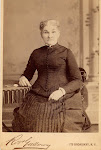

On June 9, 1880 the census taker found W. F. Walch, 22, living alone at his home in Harper Township. Under the heading Occupation the census taker simply wrote that W. F. was "at home." Normally he would have written "unoccupied" for the able that were unemployed. So, what was occupying W.F. on that June 9th? Possibly, he was settling his affairs in Harper just three months after he moved there. A week before on June 2nd William Fletcher Walch had married Caroline "Carrie” Leasure, 22, in Pawnee County, Kansas. Carrie was the daughter of John Boyd Leasure a shoemaker and cobbler in Larned. William had returned from Larned that week, a distance of 120 miles, and left the care of his bride to her family.
William eventually returned to his wife in Larned where their first child was born on the 20th of March in 1881. William Wilbur Walch, who was called Will, said he was born in a sod house -- the ‘starter home’ for newlyweds in Kansas at that time.
Prairie grasses covered much of Kansas then -- Big Bluestem, Switchgrass, and Buffalo Grass, just to name a few. Over centuries of grow, these grasses created a thick, root-bound turf that was tough yet flexible, and was a ready building material where lumber was in short supply. The sod was cut into thick squares and stacked as building blocks. The most primitive were simply igloo-like dwellings, but most were rectangular, sod walls supporting a beamed roof, which was also covered in sod. A wooden door and a window or two completed the structure. One drawback was that it often leaked, leading to wet bedding and clothing after a heavy rain. Not the most hygienic home, but it proved to be cool in the hot Kansas summer and warm in the winter. But as soon as they could afford it, a farm family would build a lumber frame house and leave the sod house to slowly decay.
In 1800, the city of Larned was a bustling cow town on the Santa Fe Trail, just 60 miles up the trail from Dodge City. In 1878, Larned was the largest city in Pawnee County with a population of 716, which was 40 percent of the county population. Larned was first settled just eight years before William Walch arrived, and was growing at such a rate that the agricultural production in the county had increased by more than 2,708 percent in the four years prior to his arrival. The Walchs would add one more child to this boom: Lizzie Belle Walch on the 26th of June 1883. The following year, the 1884 Kansas State Census shows the W. F. Walch family of four living in the city of Larned, where William was working as a druggist.
On January 28, 1887 William and Carrie’s last child was born in Topeka, Kansas: Stephen Fletcher Walch (my grandfather). Two years later William was likely the same W. Walch who submitted a bill for $2.70 for 18 hours of labor on the construction of the first school in Gutherie, Oklahoma - the same town in the same year his brother James staked a claim in the Oklahoma Land Rush of 1889.
When Stevie Walch was a young boy his father left home to ostensibly find better work. It is not known whether the marriage was strained before he left or if the time away took its toll. In any case William never returned home; and the marriage dissolved.
William may have gone to California for a time but eventually returned to Hastings-on-Hudson where he stayed with his mother. By 1900, 42-year-old William was living in Baltimore, Maryland, on 1001 Scott St. with his new wife, Alice Z. Walch, 37, of New York. He was working as a drug clerk at the time.
William died in 1906 at age 48 in a streetcar accident in Poughkeepsie, New York. It was said that he was buried there in Union Cemetery but the cemetery record does not list him. Perhaps he was buried alongside other family members in Hastings. In any event, his wife Alice returned to Yonkers where she was working as a hotel housekeeper in 1910.
Back in Arkansas City, Kansas, William children were fathered by their Grandfather John Leisure, who had moved to “Ark City.” There was at least one upside to William's absence: years later his son Stephen said his deep sense of abandonment as a child helped to steady him through rough periods of his own marriage, the rough periods all marriages inevitably encounter.
The first photo above is Main Street of Larned, Kansas, in 1880. The William Walch family photograph is courtesy of Anne Haskin of Lansing, Michigan, William’s great-granddaughter. Click on photo to enlarge.








